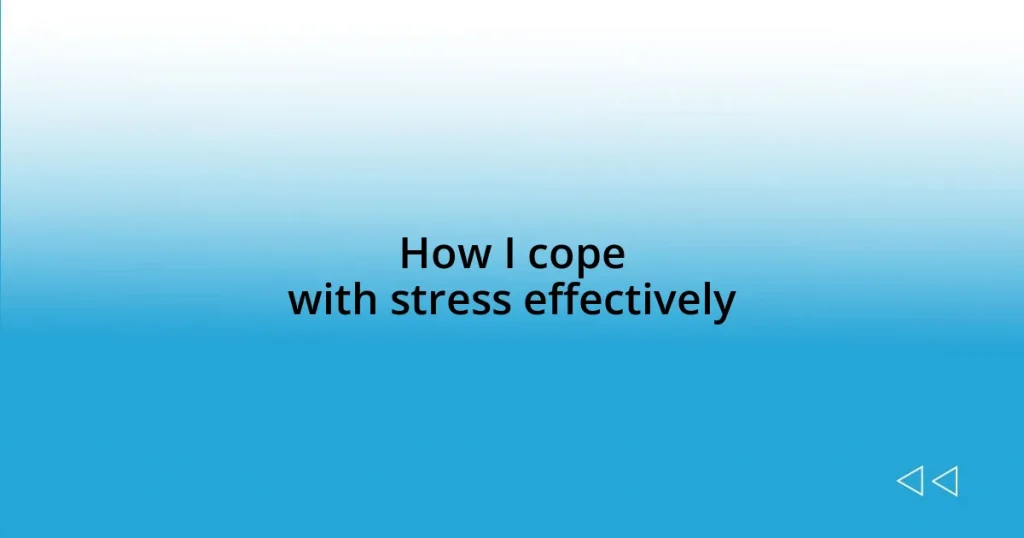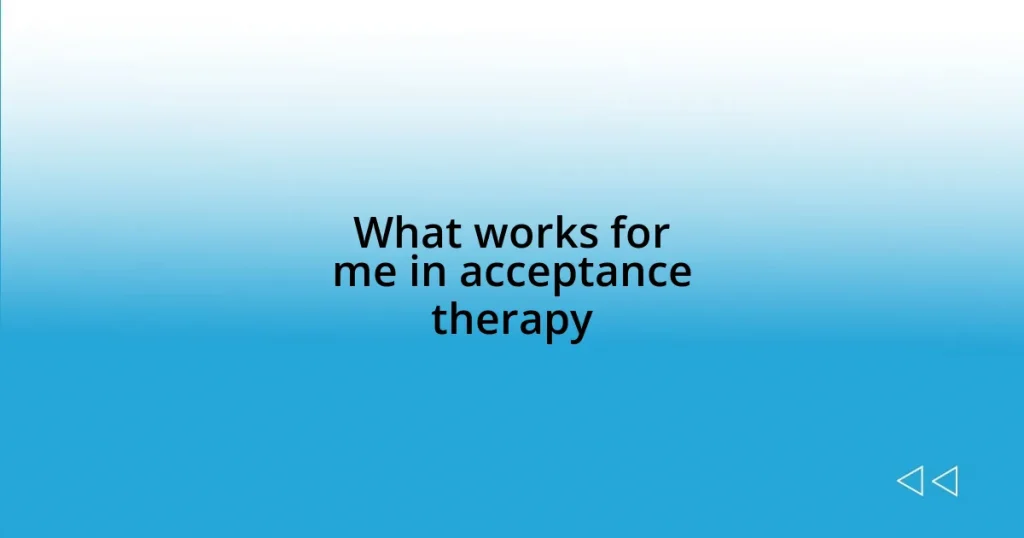Key takeaways:
- Understanding stress triggers, such as environmental factors and emotional responses, is crucial for effective stress management.
- Mindfulness techniques, like mindful breathing and gratitude journaling, can help ground individuals and reshape their mental space.
- Physical activities, including yoga, running, and dancing, serve as effective stress relief methods by fostering connection between body and mind.
- Building a support network is vital, as sharing challenges with others can provide emotional comfort and collaborative solutions.
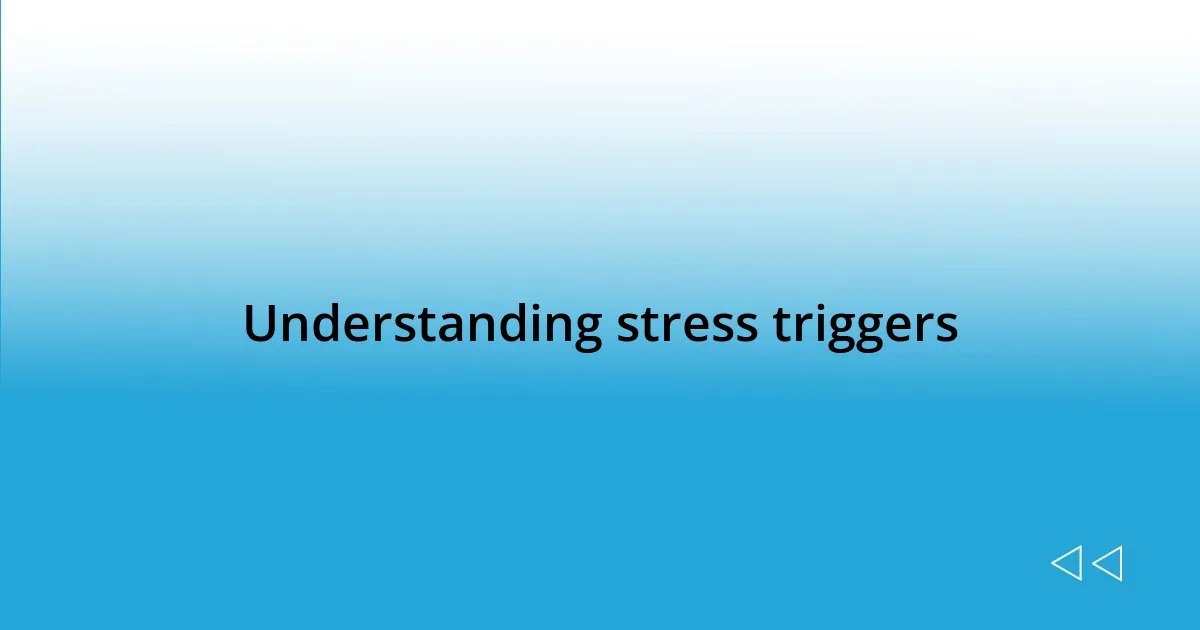
Understanding stress triggers
Stress triggers can manifest in many forms, often sneaking up on us when we least expect them. For instance, I once found myself utterly overwhelmed before a major presentation, simply because I was unprepared. Reflecting on that moment, I realized that my anxiety stemmed from a lack of confidence, which is a common trigger for many.
Have you ever noticed how certain environments or situations can raise your stress levels? During a particularly busy week at work, I realized that the constant noise and interruptions on my open office floor made me feel anxious and unfocused. This taught me that my surroundings play a significant role in how I experience stress. Understanding these triggers can be the key to managing them more effectively.
I often find it insightful to pinpoint the specific emotions tied to my stress. For example, a missed deadline can stir up feelings of inadequacy that linger long after the task is done. Recognizing this emotional response allows me to address the root cause rather than just the symptoms. How often do we acknowledge that our stress is linked to deeper feelings? It’s a powerful realization that can shape our coping strategies.
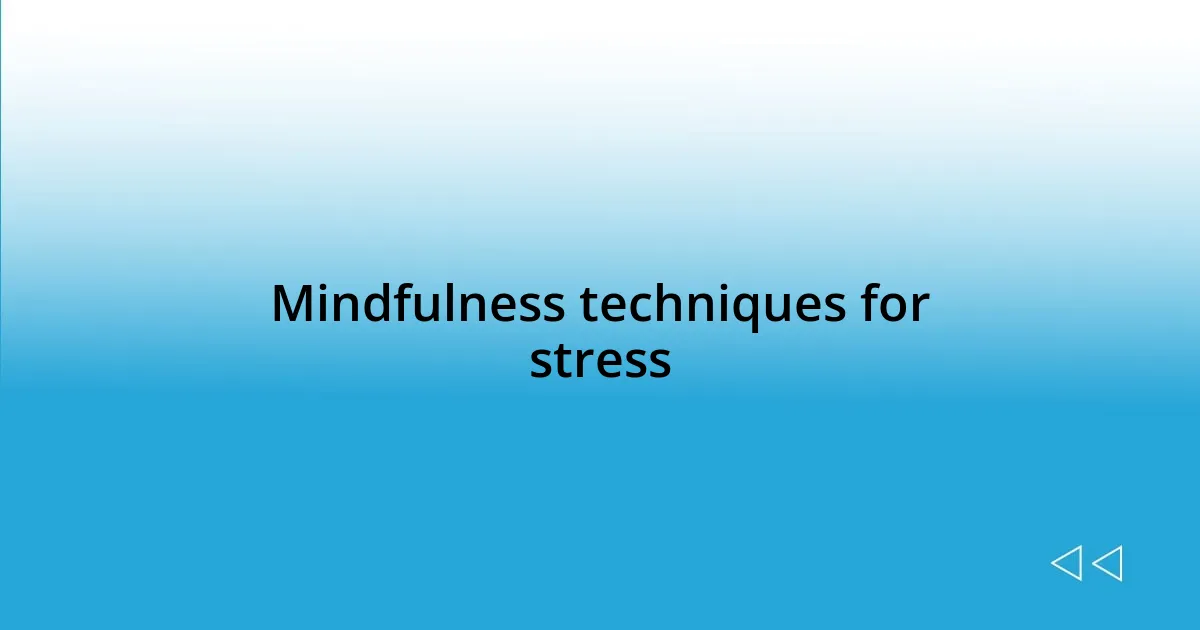
Mindfulness techniques for stress
Mindfulness techniques are essential tools I rely on to manage stress effectively. One approach that stands out for me is mindful breathing. I vividly remember a hectic morning when I was juggling multiple deadlines. Taking just a few minutes to focus on my breath helped ground me. I closed my eyes and inhaled deeply, feeling the air fill my lungs. It brought me back to the present, clearing my mind and allowing me to tackle my tasks with renewed focus.
Here are a few mindfulness techniques you can try:
- Mindful Breathing: Simply focus on your breath. Inhale deeply through your nose and exhale slowly through your mouth.
- Body Scan: Pay attention to different parts of your body, releasing tension as you go. I often start from my toes and work my way up to my head.
- Gratitude Journaling: Write down things you’re grateful for each day. I’ve found this practice shifts my mindset and reduces stress.
- Guided Imagery: Picture a calm scene in your mind, like a beach or forest. This not only relaxes me but also creates a mental escape from my stressors.
- Walking Meditation: Combine movement with mindfulness. As I walk, I focus on the sensations in my feet and the rhythm of my breath. It’s particularly effective for clearing mental fog.
Incorporating these techniques into my routine has been transformative. Just by being present, I can reframe my thoughts and create a positive mental space.
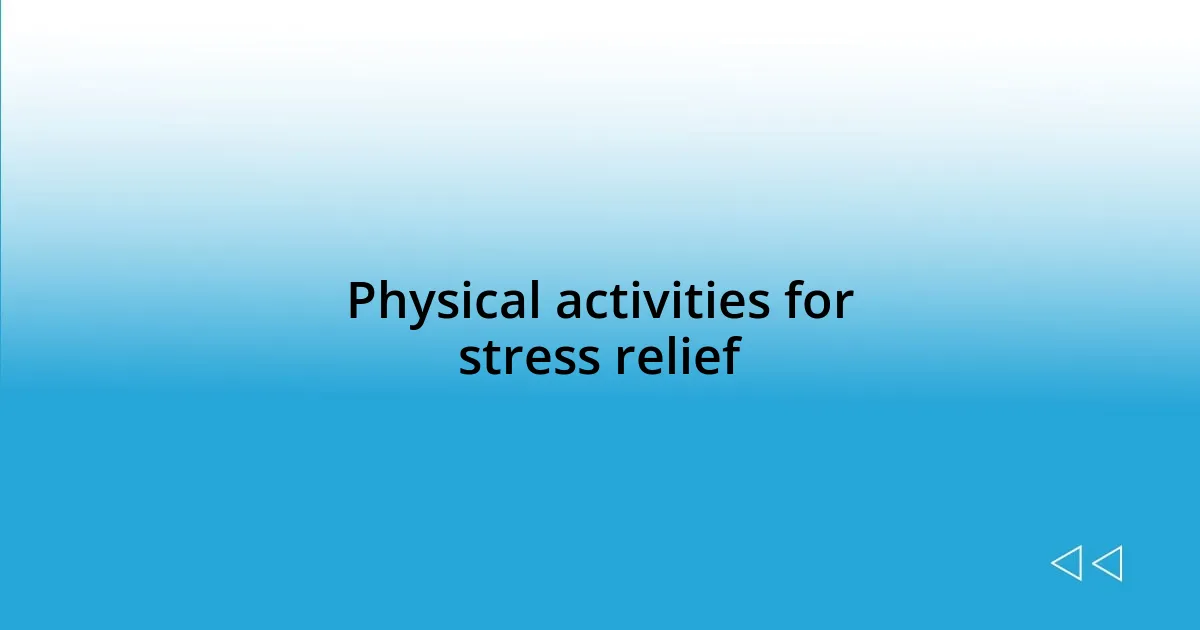
Physical activities for stress relief
Engaging in physical activities has been a game-changer for me when it comes to managing stress. I remember one particularly stressful period at work; I decided to sign up for a local yoga class. The moment I stepped onto the mat, I felt a wave of calm wash over me. Focusing on my breath and movement, I found an incredible release of tension. Yoga, with its mindful approach to physicality, taught me how to connect my body and mind, transforming stress into sheer relaxation.
Another effective activity I often turn to is running. There’s something about hitting the pavement that clears my mind. I still recall my first 5K; I was nervous, feeling the weight of both expectations and anxiety. But as I ran, I experienced a mental shift. The rhythmic pounding of my feet against the ground effectively shook off my worries. Running creates a natural high; those endorphins really do work wonders for stress relief! I often think about how just a simple jog can shift my perspective and fill me with positivity.
I can’t overlook the power of dancing. There’s a unique joy that comes from moving freely to music. During one particularly challenging week, I had friends over for some impromptu dance-offs in my living room. Letting loose and sharing those laughs was therapeutic. It reminded me that sometimes the best stress-relief comes from joyous, spontaneous moments. Physical activity can take various forms, and it’s all about finding what resonates with you personally.
| Activity | Benefits |
|---|---|
| Yoga | Increases mindfulness, reduces tension, promotes relaxation. |
| Running | Boosts mood through endorphin release, clears the mind. |
| Dancing | Encourages self-expression, enhances social connections, lifts spirits. |
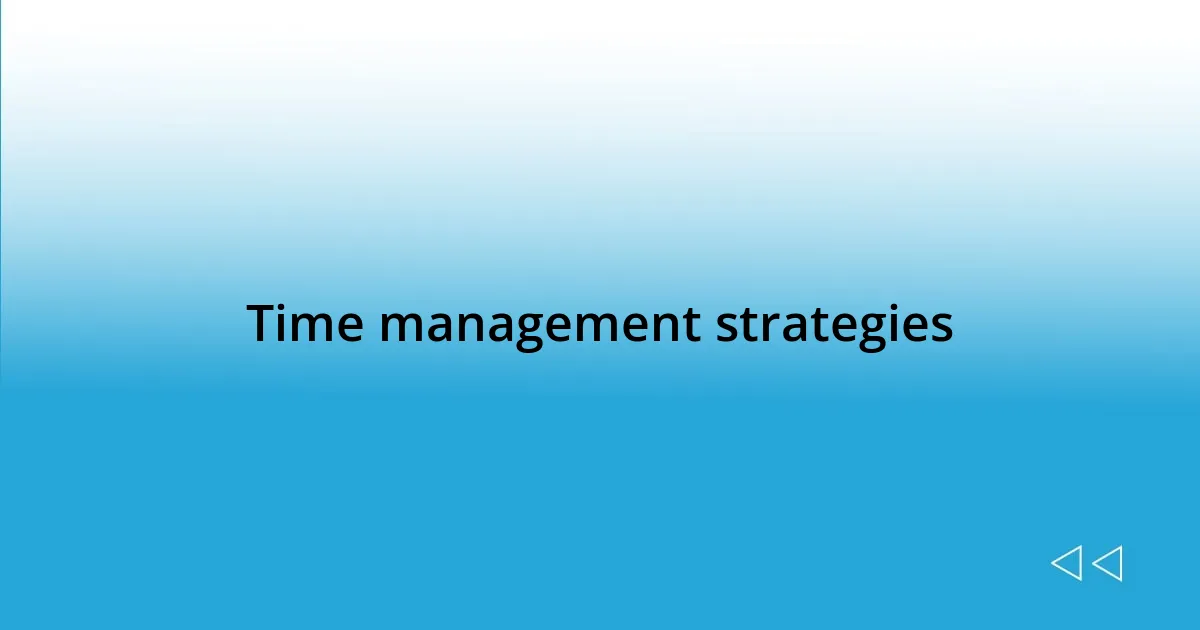
Time management strategies
Time management strategies have a significant impact on my ability to cope with stress. One technique I’ve adopted is the Pomodoro Technique. I remember the first time I used it during a particularly overwhelming project. By breaking my work into 25-minute blocks followed by 5-minute breaks, I noticed I could maintain focus without feeling burnt out. It’s fascinating how just a little structure can provide such relief and boost productivity.
I also find that prioritizing tasks helps me maintain my sanity. I usually create a to-do list at the beginning of each day, ranking my tasks by importance and urgency. On particularly busy mornings, I take a moment to reflect: “What truly needs my attention today?” This simple practice can feel empowering and clarifying, transforming chaos into a manageable plan. It’s like having a roadmap, guiding me smoothly through my day, rather than feeling lost amidst my responsibilities.
Another method that has worked wonders for me is setting specific time limits for tasks. I used to spend hours on projects without realizing how much time was slipping away. Now, I challenge myself to complete specific tasks within a set timeframe. Recently, I had a deadline sneaking up on me, and by committing to a strict hour for a section of my work, I found I could achieve more than I expected. Have you ever noticed how a ticking clock can act as a catalyst? It creates a sense of urgency that can push you to work more efficiently.
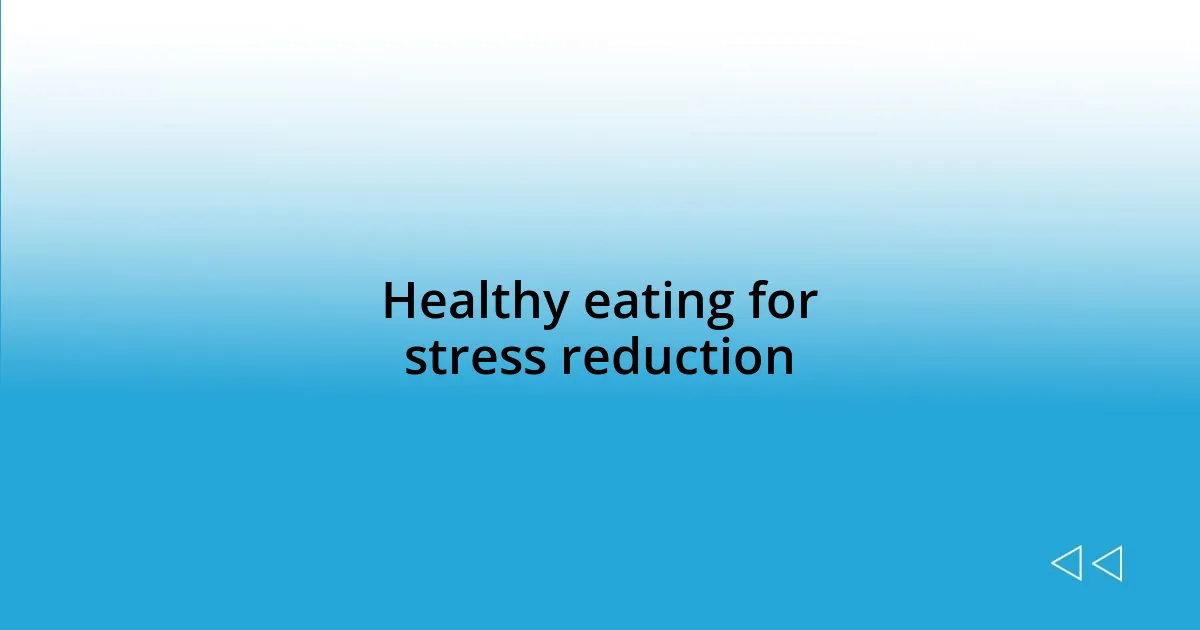
Healthy eating for stress reduction
Eating well has been a pivotal aspect of my stress management toolkit. I can recall a particularly hectic time when I found myself reaching for quick, processed meals. The more I did this, the more tired and irritable I became. Once I shifted my focus to whole foods—like leafy greens, lean proteins, and nuts—I noticed a distinct boost in my mood and energy. Isn’t it fascinating how what you put into your body directly influences how you feel?
I’ve learned that certain foods can actively combat stress. For example, omega-3 fatty acids found in salmon and walnuts have been linked to reduced anxiety levels. When I added these to my plate, I felt a sense of calm wash over me. It’s like my body was thanking me for the good stuff! I often ask myself, “How can a meal make such a difference?” The connection between diet and mental wellness is so real.
Another simple yet effective change I made was to incorporate more hydration into my routine. I used to forget to drink water throughout my busy days, which led to headaches and irritability. Now, I aim for at least eight glasses a day, and I’ve even started flavoring my water with slices of lemon or cucumber. It’s refreshing and makes me feel invigorated. Have you ever noticed how just a little hydration can elevate your mood? For me, these small dietary shifts have proven to be both nourishing and restorative in my battle against stress.
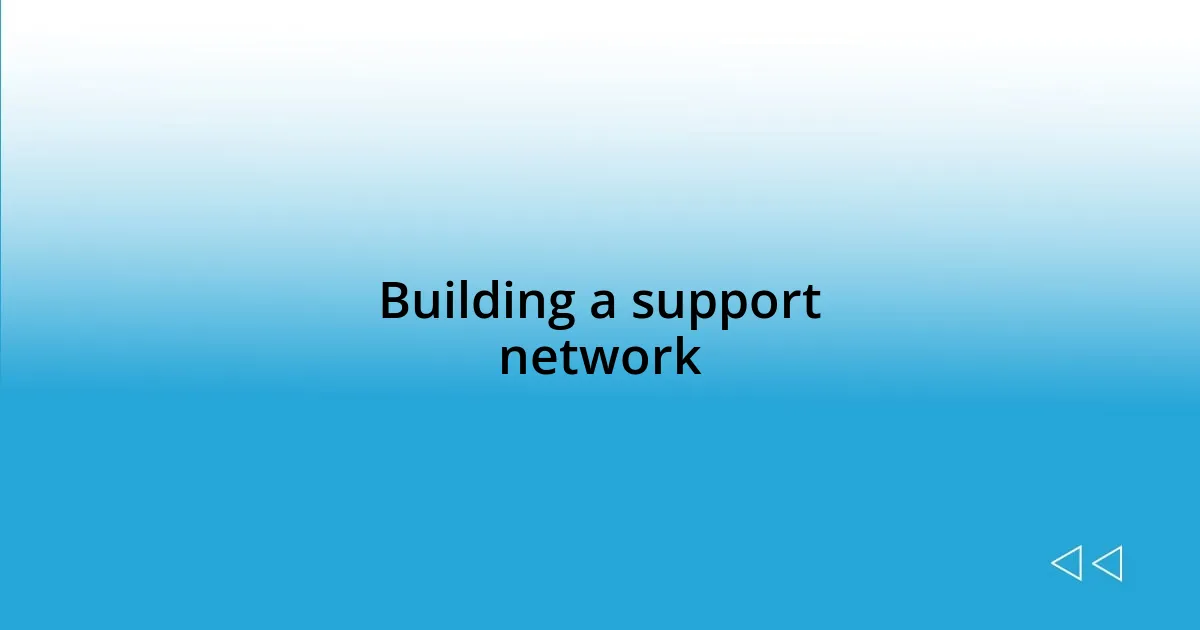
Building a support network
Building a support network is something I deeply value in managing stress. There was a time when I considered tackling my challenges alone, convinced that seeking help was a sign of weakness. However, after reaching out to a few close friends during a particularly tough period, I realized how essential their support was. It made me wonder, why do we often hesitate to lean on others when they can genuinely lighten our load?
I’ve found that different people offer varying types of support. Some friends provide a listening ear, while others motivate me to take action. I remember sharing my feelings of being overwhelmed with a colleague who had faced similar issues. By simply having that conversation, I felt a wave of relief. It’s as if their understanding validated my feelings, reminding me that I wasn’t alone in this.
Creating a diverse support network isn’t just about emotional comfort; it often leads to practical solutions as well. Recently, my group of friends collaborated on a project, pooling our skills and insights. I was amazed at how much more manageable it felt to tackle the task with collective effort. This experience made me reflect on how critical it is to nurture these relationships; they can transform stress from a burden into a shared challenge, allowing us to thrive together.
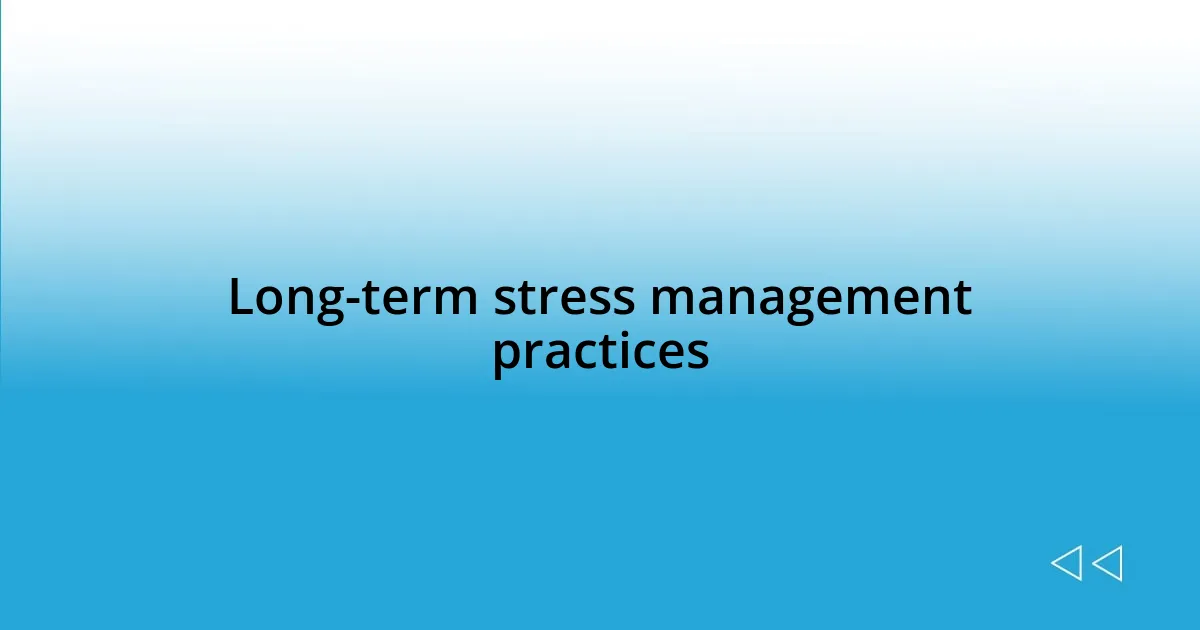
Long-term stress management practices
I’ve discovered that regular physical activity plays a crucial role in my long-term stress management. Initially, I thought hitting the gym was just about staying fit. But after committing to a routine, I realized how it worked wonders for my mind, too. There were days when I could feel anxiety creeping in, but once I engaged in a run or a yoga session, I found my worries slipping away. Isn’t it incredible how moving your body can clear your mind?
In addition to exercise, I’ve embraced mindfulness practices, which have become invaluable for maintaining balance. During a particularly overwhelming phase in my life, I stumbled upon meditation. At first, sitting in silence felt daunting, but I gradually learned to focus on my breath. After only a few minutes of this practice, I could feel my stress levels dropping. I often wonder, how did I ever cope without this simple tool?
Another essential practice I’ve integrated is establishing a daily routine. I used to thrive in chaos, thinking spontaneity was preferable. However, I found that having a structured day provides a comforting anchor. I carve out specific time for tasks, relaxation, and even my hobbies. Now, when I sit down to enjoy a book or a hobby, it feels like a reward rather than an afterthought. Isn’t it fascinating how setting intentions for each day can guide us toward a more peaceful state of mind?











